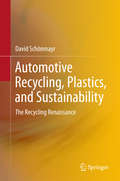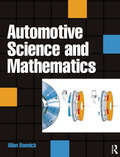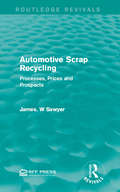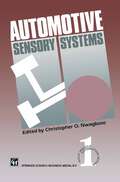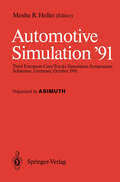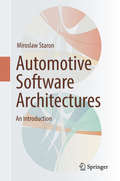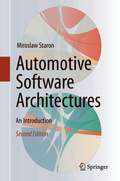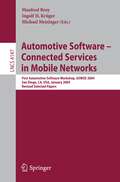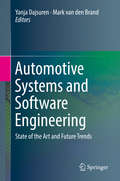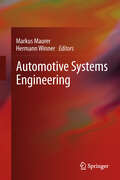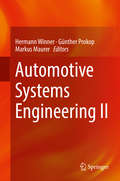- Table View
- List View
Automotive Recycling, Plastics, and Sustainability: The Recycling Renaissance
by David SchönmayrThis book provides transdisciplinary analyses of the automotive plastics production and recycling system, including prognoses, scenarios and solutions for corporate sustainability management.A book on plastics, not written by a plastics guy. But a sustainability guy. Plastics schizophrenia and the automotive abyss: The industry is facing a severe challenge. It is the inevitable and promising change towards a sustainable economy. However, the automotive industry is primarily concerned with the CO2 emissions from cars when driving, while the rise of lightweight plastics, electric drive and heavy batteries make the production and end-of-life phase ever more important. Therefore, the currently increasing use of non-sustainable virgin plastics in cars has to be tackled.The plastics and the automotive industry now have a chance, and this chance is the Recycling Renaissance.This book offers:• Holistic and transdisciplinary overview on sustainability and automotive plastics from all angles including economy, ecology, technology, and politics with a focus on Europe• Concise analyses, prognoses, tools and a roadmap with solutions for companies, developed together with international experts from industry and academia • Strong scientific basis and independent research including a Europe-wide survey, expert interviews, and workshops• More than 80 illustrations and 15 tables including a SCOT analysis • Executive summaries after each chapter for fast reading“The uniqueness of this book lies within the different point of view on this topic from a critical, outstanding scientist.” - Univ.-Prof. Dipl.-Ing. Dr.mont. Pomberger, Montanuni Leoben
Automotive Science and Mathematics
by Allan BonnickAutomotive technicians and students need a firm grasp of science and technology in order to fully appreciate and understand how mechanisms and systems of modern vehicles work. Automotive Science and Mathematics presents the necessary principles and applications with all the examples and exercises relating directly to motor vehicle technology and repair, making it easy for automotive students and apprentices to relate the theory back to their working practice.The coverage of this book is based on the syllabus requirements of the BTEC First in Vehicle Technology, BTEC National in Vehicle Repair and Technology, and the IMI Certificate and Diploma in Vehicle Maintenance and Repair, but will help all automotive students and apprentices at levels 2 and 3 and up to and including HNC/HND, foundation and first degree with their studies and in achieving the Key Skill 'Application of Number' at levels 2 and 3. The book is designed to cater for both light and heavy vehicle courses.Full worked solutions of most exercises are available as a free download for lecturers only from http://textbooks.elsevier.com.Allan Bonnick is a motor vehicle education and training consultant and was formerly Head of Motor Vehicle Engineering, Eastbourne College. He is the author of several established automotive engineering textbooks.
Automotive Science and Mathematics
by Allan BonnickAutomotive technicians and students need a firm grasp of science and technology in order to fully appreciate and understand how mechanisms and systems of modern vehicles work. Automotive Science and Mathematics presents the necessary principles and applications with all the examples and exercises relating directly to motor vehicle technology and repair, making it easy for automotive students and apprentices to relate the theory back to their working practice.The coverage of this book is based on the syllabus requirements of the BTEC First in Vehicle Technology, BTEC National in Vehicle Repair and Technology, and the IMI Certificate and Diploma in Vehicle Maintenance and Repair, but will help all automotive students and apprentices at levels 2 and 3 and up to and including HNC/HND, foundation and first degree with their studies and in achieving the Key Skill 'Application of Number' at levels 2 and 3. The book is designed to cater for both light and heavy vehicle courses.Full worked solutions of most exercises are available as a free download for lecturers only from http://textbooks.elsevier.com.Allan Bonnick is a motor vehicle education and training consultant and was formerly Head of Motor Vehicle Engineering, Eastbourne College. He is the author of several established automotive engineering textbooks.
Automotive Scrap Recycling: Processes, Prices and Prospects (Routledge Revivals)
by James. W SawyerAutomotive Scrap Recycling provides a qualitative description of the steel scrap industry by focussing on its largest segment: conversion of obsolete cars into steel scrap. Originally published in1974, this report covers issues such as the structure of the industry and quality problems with scrap steel as well as related policy issues. This title will be of interest to students of Environmental Studies.
Automotive Scrap Recycling: Processes, Prices and Prospects (Routledge Revivals)
by James. W SawyerAutomotive Scrap Recycling provides a qualitative description of the steel scrap industry by focussing on its largest segment: conversion of obsolete cars into steel scrap. Originally published in1974, this report covers issues such as the structure of the industry and quality problems with scrap steel as well as related policy issues. This title will be of interest to students of Environmental Studies.
Automotive Sensory Systems
by C. NwagbosoThe rapidly growing need for mobility has brought with it a major challenge for improvement in the operation and utilization of automotive systems. The economical, environmental and safety constraints imposed by the increase in the number of road vehicles and subsequent government policies also require substantial product development through the application of infor mation technology. This involves the enhancement of vehicle informatics and telematic systems with additional sensors and systems. The advance in the design and development of automotive sensory systems is so rapid that there is urgent need for the experts involved in the technology to work together to provide a reference book for the engineer of today and tomorrow. This motivated me to spend two years researching the topics and the basis on which such a book should be written. The result is the present compilation of the work of international experts on the state-of-the-art in the field of automotive sensory systems. Thus, a unique collection has been created for the reference of all those concerned with, or interested in, the design and development of modern, safe and intelligent vehicles. Although this book is intended for engineers, managers, scientists, academicians and policy makers, students should also find it valuable. To meet the requirements of students the basics are explained in simple terms; however, it is hoped that others will appreciate this approach, since most of us are well aware that gaps remain in our knowledge of the elements of our profession.
Automotive Simulation ’91: Proceedings of the 3rd European Cars/Trucks, Simulation Symposium Schliersee, Germany, October 1991
by Moshe R. HellerWelcome to Bavaria - Germany - to the THIRD EUROPEAN CARS/TRUCKS SIMULATION SYMPOSIUM. That Schliersee traditional workshop-type meeting is a follow-up to the first and the second symposia which took place in May 1984 and May 1989 respectively. The objective of gathering together is to cover most of the aspects of Automotive Mathematical Modelling and Simulation in theory and practice to promote the exchange of knowledge and experience between different national and international research groups in that field, taking into consideration that every seventh German employee is related to the automotive industry. This effect is also in power at least with the traditional Detroit (U.S.A.) Automotive Industries and the growing up Japanease as well. Futhermore, there is to strenghten the international contact between developers and users of modelling and simulation techniques considering the "new world order" started in 1991 with no borders between West and East affected by the Golf-War and followed up by the "open" European Community borders of 1992. VI The traditional International Conference jointly promoted by ASIMUTH - Applied Simulation Technology and some other members of the Society of Computer Simulaton created an interest to publish new projects including their results. A large number of contributed papers has been strictly examined and selected by the editorial commitee to guarantee a high international technical standard.
Automotive Software Architectures: An Introduction
by Miroslaw StaronThis book introduces the concept of software architecture as one of the cornerstones of software in modern cars. Following a historical overview of the evolution of software in modern cars and a discussion of the main challenges driving that evolution, Chapter 2 describes the main architectural styles of automotive software and their use in cars’ software. In Chapter 3, readers will find a description of the software development processes used to develop software on the car manufacturers’ side. Chapter 4 then introduces AUTOSAR – an important standard in automotive software. Chapter 5 goes beyond simple architecture and describes the detailed design process for automotive software using Simulink, helping readers to understand how detailed design links to high-level design. Next, Chapter 6 presents a method for assessing the quality of the architecture – ATAM (Architecture Trade-off Analysis Method) – and provides a sample assessment, while Chapter 7 presents an alternative way of assessing the architecture, namely by using quantitative measures and indicators. Subsequently Chapter 8 dives deeper into one of the specific properties discussed in Chapter 6 – safety – and details an important standard in that area, the ISO/IEC 26262 norm. Lastly, Chapter 9 presents a set of future trends that are currently emerging and have the potential to shape automotive software engineering in the coming years.This book explores the concept of software architecture for modern cars and is intended for both beginning and advanced software designers. It mainly aims at two different groups of audience – professionals working with automotive software who need to understand concepts related to automotive architectures, and students of software engineering or related fields who need to understand the specifics of automotive software to be able to construct cars or their components. Accordingly, the book also contains a wealth of real-world examples illustrating the concepts discussed and requires no prior background in the automotive domain.
Automotive Software Architectures: An Introduction
by Miroslaw StaronThis book introduces the concept of software architecture as one of the cornerstones of software in modern cars. Following a historical overview of the evolution of software in modern cars and a discussion of the main challenges driving that evolution, Chapter 2 describes the main architectural styles of automotive software and their use in cars’ software. Chapter 3 details this further by presenting two modern architectural styles, i.e. centralized and federated software architectures. In Chapter 4, readers will find a description of the software development processes used to develop software on the car manufacturers’ side. Chapter 5 then introduces AUTOSAR – an important standard in automotive software. Chapter 6 goes beyond simple architecture and describes the detailed design process for automotive software using Simulink, helping readers to understand how detailed design links to high-level design. The new chapter 7 reports on how machine learning is exploited in automotive software e.g. for image recognition and how both on-board and off-board learning are applied. Next, Chapter 8 presents a method for assessing the quality of the architecture – ATAM (Architecture Trade-off Analysis Method) – and provides a sample assessment, while Chapter 9 presents an alternative way of assessing the architecture, namely by using quantitative measures and indicators. Subsequently Chapter 10 dives deeper into one of the specific properties discussed in Chapter 8 – safety – and details an important standard in that area, the ISO/IEC 26262 norm. Lastly, Chapter 11 presents a set of future trends that are currently emerging and have the potential to shape automotive software engineering in the coming years. This book explores the concept of software architecture for modern cars and is intended for both beginning and advanced software designers. It mainly aims at two different groups of audience – professionals working with automotive software who need to understand concepts related to automotive architectures, and students of software engineering or related fields who need to understand the specifics of automotive software to be able to construct cars or their components. Accordingly, the book also contains a wealth of real-world examples illustrating the concepts discussed and requires no prior background in the automotive domain. Compared to the first edition, besides the two new chapters 3 and 7 there are considerable updates in chapters 5 and 8 especially.
Automotive Software-Connected Services in Mobile Networks: First Automotive Software Workshop, ASWSD 2004, San Diego, CA, USA, January 10-12, 2004, Revised Selected Papers (Lecture Notes in Computer Science #4147)
by Manfred Broy Ingolf Krüger Michael MeisingerThis book constitutes the thoroughly refereed post-proceedings of the First Automotive Software Workshop, ASWD 2004, held in San Diego, CA, USA in January 2004. The 10 revised full papers presented were carefully reviewed and selected from 26 lectures held at the workshop that brought together experts from industry and academia, working on highly complex, distributed, reactive software systems related to the automotive domain.
Automotive Software Engineering: Grundlagen, Prozesse, Methoden und Werkzeuge effizient einsetzen (ATZ/MTZ-Fachbuch)
by Jörg Schäuffele Thomas ZurawkaDieses Fachbuch enthält die Grundlagen sowie zahlreiche Anregungen und praktische Beispiele zu Prozessen, Methoden und Werkzeugen, die zur sicheren Beherrschbarkeit von elektronischen Systemen und Software im Fahrzeug beitragen. Dabei werden der AUTOSAR-Standard und die Norm ISO 26 262 durchgehend behandelt. Die aktuelle Auflage berücksichtigt Elektro- und Hybridantriebskonzepte sowie Fahrerassistenzsysteme und enthält die Grundlagen zu Produktlinien- und Variantenmanagement. Seit Anfang der 1970er Jahre ist die Entwicklung von Kraftfahrzeugen geprägt von einem rasanten Anstieg des Einsatzes von Elektronik und Software. Dieser Trend hält bis heute an und wird getrieben von steigenden Kunden- und Umweltanforderungen. Nahezu alle Funktionen des Fahrzeugs werden inzwischen elektronisch gesteuert, geregelt oder überwacht. Die Realisierung von Funktionen durch Software bietet einzigartige Freiheitsgrade beim Entwurf. In der Fahrzeugentwicklung müssen jedoch Randbedingungen wie hohe Zuverlässigkeits- und Sicherheitsanforderungen, lange Produktlebenszyklen, begrenzte Kostenrahmen, kurze Entwicklungszeit und zunehmende Variantenvielfalt berücksichtigt werden. In diesem Spannungsfeld steht Automotive Software Engineering.
Automotive Software Engineering: Grundlagen, Prozesse, Methoden und Werkzeuge effizient einsetzen (ATZ/MTZ-Fachbuch)
by Jörg Schäuffele Thomas ZurawkaNahezu alle Funktionen des Fahrzeugs werden inzwischen elektronisch gesteuert, geregelt oder überwacht. Die Realisierung von Funktionen durch Software bietet einzigartige Freiheitsgrade beim Entwurf. In der Fahrzeugentwicklung müssen jedoch Randbedingungen wie hohe Zuverlässigkeits- und Sicherheitsanforderungen, vergleichsweise lange Produktlebenszyklen, begrenzte Kosten, verkürzte Entwicklungszeiten und zunehmende Variantenvielfalt berücksichtigt werden. Dieses Buch enthält Grundlagen und praktische Beispiele zu Prozessen, Methoden und Werkzeugen, die zur sicheren Beherrschbarkeit von elektronischen Systemen und Software im Fahrzeug beitragen. Dabei stehen die elektronischen Systeme des Antriebsstrangs, des Fahrwerks und der Karosserie im Vordergrund. In allen relevanten Kapiteln ist die aktuelle Thematik 'AUTOSAR' integriert.
Automotive Software Engineering: Grundlagen, Prozesse, Methoden und Werkzeuge effizient einsetzen (ATZ/MTZ-Fachbuch)
by Jörg Schäuffele Thomas ZurawkaNahezu alle Funktionen des Fahrzeugs werden inzwischen elektronisch gesteuert, geregelt oder überwacht. Die Realisierung von Funktionen durch Software bietet einzigartige Freiheitsgrade beim Entwurf. In der Fahrzeugentwicklung müssen jedoch Randbedingungen wie hohe Zuverlässigkeits- und Sicherheitsanforderungen, vergleichsweise lange Produktlebenszyklen, begrenzte Kosten, verkürzte Entwicklungszeiten und zunehmende Variantenvielfalt berücksichtigt werden. Dieses Buch enthält Grundlagen und praktische Beispiele zu Prozessen, Methoden und Werkzeugen, die zur sicheren Beherrschbarkeit von elektronischen Systemen und Software im Fahrzeug beitragen. Dabei stehen die elektronischen Systeme des Antriebsstrangs, des Fahrwerks und der Karosserie im Vordergrund. Die überarbeitete 3. Auflage enthält verbesserte Bilddarstellungen sowie ein deutsch-englisches Sachwortverzeichnis.
Automotive Software Engineering: Grundlagen, Prozesse, Methoden und Werkzeuge effizient einsetzen (ATZ/MTZ-Fachbuch)
by Jörg Schäuffele Thomas ZurawkaNahezu alle Funktionen des Fahrzeugs werden inzwischen elektronisch gesteuert, geregelt oder überwacht. Die Realisierung von Funktionen durch Software bietet einzigartige Freiheitsgrade beim Entwurf. In der Fahrzeugentwicklung müssen jedoch Randbedingungen wie hohe Zuverlässigkeits- und Sicherheitsanforderungen, vergleichsweise lange Produktlebenszyklen, begrenzte Kosten, verkürzte Entwicklungszeiten und zunehmende Variantenvielfalt berücksichtigt werden. Dieses Buch enthält Grundlagen und praktische Beispiele zu Prozessen, Methoden und Werkzeugen, die zur sicheren Beherrschbarkeit von elektronischen Systemen und Software im Fahrzeug beitragen. Dabei stehen die elektronischen Systeme des Antriebsstrangs, des Fahrwerks und der Karosserie im Vordergrund. In allen relevanten Kapiteln wurde die aktuelle Thematik AUTOSAR integriert.
Automotive Software Engineering: Grundlagen, Prozesse, Methoden und Werkzeuge (ATZ/MTZ-Fachbuch)
by Jörg Schäuffele Thomas ZurawkaNahezu alle Funktionen des Fahrzeugs werden inzwischen elektronisch gesteuert, geregelt oder überwacht. Die Realisierung von Funktionen durch Software bietet einzigartige Freiheitsgrade beim Entwurf. In der Fahrzeugentwicklung müssen jedoch Randbedingungen wie hohe Zuverlässigkeits- und Sicherheitsanforderungen, vergleichsweise lange Produktlebenszyklen, begrenzte Kosten, verkürzte Entwicklungszeiten und zunehmende Variantenvielfalt berücksichtigt werden. Dieses Buch enthält Grundlagen und praktische Beispiele zu Prozessen, Methoden und Werkzeugen, die zur sicheren Beherrschbarkeit von elektronischen Systemen und Software im Fahrzeug beitragen. Dabei stehen die elektronischen Systeme des Antriebsstrangs, des Fahrwerks und der Karosserie im Vordergrund.
Automotive Software Engineering: Grundlagen, Prozesse, Methoden und Werkzeuge (ATZ/MTZ-Fachbuch)
by Jörg Schäuffele Thomas ZurawkaNahezu alle Funktionen des Fahrzeugs werden inzwischen elektronisch gesteuert, geregelt oder überwacht. Die Realisierung von Funktionen durch Software bietet einzigartige Freiheitsgrade beim Entwurf. In der Fahrzeugentwicklung müssen jedoch Randbedingungen wie hohe Zuverlässigkeits- und Sicherheitsanforderungen, vergleichsweise lange Produktlebenszyklen, begrenzte Kosten, verkürzte Entwicklungszeiten und zunehmende Variantenvielfalt berücksichtigt werden. Dieses Buch enthält Grundlagen und praktische Beispiele zu Prozessen, Methoden und Werkzeugen, die zur sicheren Beherrschbarkeit von elektronischen Systemen und Software im Fahrzeug beitragen. Dabei stehen die elektronischen Systeme des Antriebsstrangs, des Fahrwerks und der Karosserie im Vordergrund.
Automotive Software Engineering: Grundlagen, Prozesse, Methoden und Werkzeuge (ATZ/MTZ-Fachbuch)
by Jörg Schäuffele Thomas ZurawkaDieses Fachbuch enthält die Grundlagen sowie zahlreiche Anregungen und praktische Beispiele zu Prozessen, Methoden und Werkzeugen, die zur sicheren Beherrschbarkeit von elektronischen Systemen und Software im Fahrzeug beitragen. Dabei werden der AUTOSAR-Standard und die Norm ISO 26 262 durchgehend behandelt. Die aktuelle Auflage berücksichtigt Elektro- und Hybridantriebskonzepte sowie Fahrerassistenzsysteme und enthält die Grundlagen zu Produktlinien- und Variantenmanagement. Seit Anfang der 1970er Jahre ist die Entwicklung von Kraftfahrzeugen geprägt von einem rasanten Anstieg des Einsatzes von Elektronik und Software. Dieser Trend hält bis heute an und wird getrieben von steigenden Kunden- und Umweltanforderungen. Nahezu alle Funktionen des Fahrzeugs werden inzwischen elektronisch gesteuert, geregelt oder überwacht. Die Realisierung von Funktionen durch Software bietet einzigartige Freiheitsgrade beim Entwurf. In der Fahrzeugentwicklung müssen jedoch Randbedingungen wie hohe Zuverlässigkeits- und Sicherheitsanforderungen, lange Produktlebenszyklen, begrenzte Kostenrahmen, kurze Entwicklungszeit und zunehmende Variantenvielfalt berücksichtigt werden. In diesem Spannungsfeld steht Automotive Software Engineering.
Automotive System Safety: Critical Considerations for Engineering and Effective Management (Quality and Reliability Engineering Series)
by Joseph D. MillerContains practical insights into automotive system safety with a focus on corporate safety organization and safety management Functional Safety has become important and mandated in the automotive industry by inclusion of ISO 26262 in OEM requirements to suppliers. This unique and practical guide is geared toward helping small and large automotive companies, and the managers and engineers in those companies, improve automotive system safety. Based on the author’s experience within the field, it is a useful tool for marketing, sales, and business development professionals to understand and converse knowledgeably with customers and prospects. Automotive System Safety: Critical Considerations for Engineering and Effective Management teaches readers how to incorporate automotive system safety efficiently into an organization. Chapters cover: Safety Expectations for Consumers, OEMs, and Tier 1 Suppliers; System Safety vs. Functional Safety; Safety Audits and Assessments; Safety Culture; and Lifecycle Safety. Sections on Determining Risk; Risk Reduction; and Safety of the Intended Function are also presented. In addition, the book discusses causes of safety recalls; how to use metrics as differentiators to win business; criteria for a successful safety organization; and more. Discusses Safety of the Intended Function (SOTIF), with a chapter about an emerging standard (SOTIF, ISO PAS 21448), which is for handling the development of autonomous vehicles Helps safety managers, engineers, directors, and marketing professionals improve their knowledge of the process of FS standards Aimed at helping automotive companies—big and small—and their employees improve system safety Covers auditing and the use of metrics Automotive System Safety: Critical Considerations for Engineering and Effective Management is an excellent book for anyone who oversees the safety and development of automobiles. It will also benefit those who sell and market vehicles to prospective customers.
Automotive System Safety: Critical Considerations for Engineering and Effective Management (Quality and Reliability Engineering Series)
by Joseph D. MillerContains practical insights into automotive system safety with a focus on corporate safety organization and safety management Functional Safety has become important and mandated in the automotive industry by inclusion of ISO 26262 in OEM requirements to suppliers. This unique and practical guide is geared toward helping small and large automotive companies, and the managers and engineers in those companies, improve automotive system safety. Based on the author’s experience within the field, it is a useful tool for marketing, sales, and business development professionals to understand and converse knowledgeably with customers and prospects. Automotive System Safety: Critical Considerations for Engineering and Effective Management teaches readers how to incorporate automotive system safety efficiently into an organization. Chapters cover: Safety Expectations for Consumers, OEMs, and Tier 1 Suppliers; System Safety vs. Functional Safety; Safety Audits and Assessments; Safety Culture; and Lifecycle Safety. Sections on Determining Risk; Risk Reduction; and Safety of the Intended Function are also presented. In addition, the book discusses causes of safety recalls; how to use metrics as differentiators to win business; criteria for a successful safety organization; and more. Discusses Safety of the Intended Function (SOTIF), with a chapter about an emerging standard (SOTIF, ISO PAS 21448), which is for handling the development of autonomous vehicles Helps safety managers, engineers, directors, and marketing professionals improve their knowledge of the process of FS standards Aimed at helping automotive companies—big and small—and their employees improve system safety Covers auditing and the use of metrics Automotive System Safety: Critical Considerations for Engineering and Effective Management is an excellent book for anyone who oversees the safety and development of automobiles. It will also benefit those who sell and market vehicles to prospective customers.
Automotive Systems and Software Engineering: State of the Art and Future Trends
This book presents the state of the art, challenges and future trends in automotive software engineering. The amount of automotive software has grown from just a few lines of code in the 1970s to millions of lines in today’s cars. And this trend seems destined to continue in the years to come, considering all the innovations in electric/hybrid, autonomous, and connected cars. Yet there are also concerns related to onboard software, such as security, robustness, and trust.This book covers all essential aspects of the field. After a general introduction to the topic, it addresses automotive software development, automotive software reuse, E/E architectures and safety, C-ITS and security, and future trends. The specific topics discussed include requirements engineering for embedded software systems, tools and methods used in the automotive industry, software product lines, architectural frameworks, various related ISO standards, functional safety and safety cases, cooperative intelligent transportation systems, autonomous vehicles, and security and privacy issues.The intended audience includes researchers from academia who want to learn what the fundamental challenges are and how they are being tackled in the industry, and practitioners looking for cutting-edge academic findings. Although the book is not written as lecture notes, it can also be used in advanced master’s-level courses on software and system engineering. The book also includes a number of case studies that can be used for student projects.
Automotive Systems Engineering
by Markus Maurer and Hermann WinnerThis book reflects the shift in design paradigm in automobile industry. It presents future innovations, often referred as “automotive systems engineering”. These cause fundamental innovations in the field of driver assistance systems and electro-mobility as well as fundamental changes in the architecture of the vehicles. New driving functionalities can only be realized if the software programs of multiple electronic control units work together correctly. This volume presents the new and innovative methods which are mandatory to master the complexity of the vehicle of the future.
Automotive Systems Engineering II
by Hermann Winner Günther Prokop Markus MaurerThis book is the second volume reflecting the shift in the design paradigm in automobile industry. It presents contributions to the second and third workshop on Automotive Systems Engineering held in March 2013 and Sept. 2014, respectively.It describes major innovations in the field of driver assistance systems and automated vehicles as well as fundamental changes in the architecture of the vehicles.
Automotive Technician Training: Introduction to Light Vehicle Technology
by Tom DentonA blended learning approach to automotive engineering at foundation level Used alongside the ATT Training online learning resources, this textbook covers everything that students need to learn in order to pass Introduction to Motor Vehicle Engineering (EL3) automotive courses. This book takes a blended learning approach, using interactive features that make learning more enjoyable as well as more effective. When linked with the ATT Training online resources it provides a comprehensive package that includes activities, animations, assessments and further reading. Information and activities are set out in sequence so as to meet teacher and learner needs as well as qualification requirements.
Automotive Technician Training: Introduction to Light Vehicle Technology
by Tom DentonA blended learning approach to automotive engineering at foundation level Used alongside the ATT Training online learning resources, this textbook covers everything that students need to learn in order to pass Introduction to Motor Vehicle Engineering (EL3) automotive courses. This book takes a blended learning approach, using interactive features that make learning more enjoyable as well as more effective. When linked with the ATT Training online resources it provides a comprehensive package that includes activities, animations, assessments and further reading. Information and activities are set out in sequence so as to meet teacher and learner needs as well as qualification requirements.
